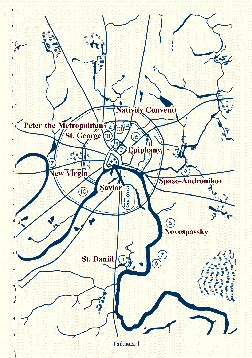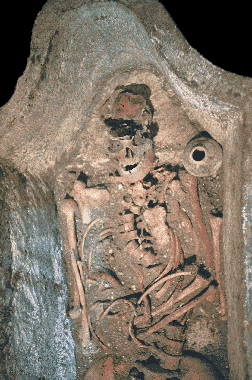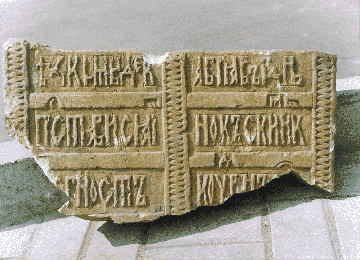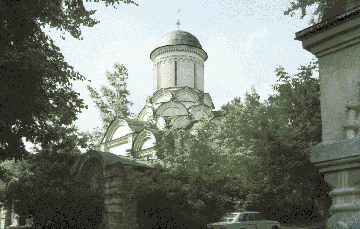|
Leonid Beliaev Institute of Archaeology,
Russian Academy of Sciences
A new branch of Moscow archaeology is devoted
to the study of the grounds of its ancient monasteries. Many reports on the
projects completed from the 1980s-1990s have already been published in both
Russian and English (Beliaev 1997). The following will be limited to
generalizations based on both compiled data and information gained from recent
projects. The earliest
monasteries appeared on the contemporary territory of Russia in the 11th
century. However, buildings dating to the 12th-15th c. have very rarely survived
(fig.1). Preserved complexes mainly belong to the 17th-19th centuries, and
a few to the 16th. There were three periods when mass destruction of monastic
foundations took place: 1) in the 1230-40s, during the Mongol invasion of
northeastern and southern Russia, when many monasteries were burnt and razed
to the ground (see AR, 1,3); 2) in the 18th c., during the reigns of first
Peter the Great, and later Catherine II, when a vast number of monasteries
were suppressed and their lands vested with the Crown (these reforms resembled
Dissolution in 16th c. England); 3) under the Soviet regime, when the violent
communist persecution entailed the destruction of almost all ecclesiastical
centers. The monastic archaeology of Russia is thus a field of great potential.
But until recently, this field was underdeveloped. Scholars did  not perceive
existing monasteries and monastic centers as objects of archaeological interest.
Only in the post-World War II years have a number of the most prominent monastic
centers been studied archaeologically. Active archaeological projects were
carried out in the period from 1983 to 1993, during which the old Soviet
bureaucracy weakened strict control over religious life in Russia, and monastic
centers were opened to scholars. Vast excavations started in Moscow and in
the city’s vicinity (e.g., Pafnutiev-Borovsky Monastery). Now, after
all church buildings and monasteries have been returned to the Church,
archaeological work is allowed when it directly serves Church interests,
such as the excavation of relics or religious buildings intended for consecration
by the holy fathers. not perceive
existing monasteries and monastic centers as objects of archaeological interest.
Only in the post-World War II years have a number of the most prominent monastic
centers been studied archaeologically. Active archaeological projects were
carried out in the period from 1983 to 1993, during which the old Soviet
bureaucracy weakened strict control over religious life in Russia, and monastic
centers were opened to scholars. Vast excavations started in Moscow and in
the city’s vicinity (e.g., Pafnutiev-Borovsky Monastery). Now, after
all church buildings and monasteries have been returned to the Church,
archaeological work is allowed when it directly serves Church interests,
such as the excavation of relics or religious buildings intended for consecration
by the holy fathers.
Fig.1: Map of monasteries established from the late 13th-early 15th c.,
in and around Moscow (L. Beliaev).
Some of the recent investigations, however, have been followed by numerous
restrictions that have resulted in damages and scandals. As an example of
the latter, the Spaso-Andronikov Monastery in Moscow has a main church dating
from the late 14th - early 15th c., constituting the earliest surviving church
building in Moscow. In 1993 the parish sponsored “secret” excavations
in the vicinity of the ancient altar. Under layers of the construction fill,
they discovered a well-preserved 14th c. cemetery, predating the church.
While neither reports nor publications appeared, bones discovered there were
classified as “relics,” although several archaeologists who worked
on the project gave contradictory descriptions, interpretations, and dates
to the remains. “Relics” were even continually discovered in tombs
already announced as empty. The situation did not improve until 2001, when
the parish realized the need to invite a team of professional archaeologists
to survey the excavation results.
Of the 15 or 20 monasteries existing in Moscow at the beginning of the 15th
century, only three have been seriously studied (the Danilov Monastery, the
Monastery of the Epiphany; and the Monastery of Peter-the-Metropolitan),
and several others have been partially excavated.
Excavations in Moscow monasteries mainly concentrate upon three points: layers
of early settlements; foundations of monastic churches; and necropolises.
The remains of monastic churches help to determine general stratigraphy and
dating. During three excavation seasons (1985-87) the remains of the Monastery
of the Epiphany (Moscow) were uncovered. Its stone cathedral, believed to
have been built in the late 1330s, in fact is dated to the late 14th century,
and had a predecessor, a wooden church built at the end of the 13th century,
which was destroyed, possibly by fire.  As a result, we can further determine the history of monastic planning,
architecture, burial rituals (fig.2), and related subjects. Unlike in the West, monasteries
in Russia inherited the Byzantine tradition, had no established and prescribed
layouts, and, most importantly, lacked cloisters. General planning varied
widely in its form. In an open field it might follow the relief of hills
and valleys; in a city it had to be planned with reference to the plot of
land. From the late 15th c., we observe a tendency to develop an area enclosed
by a wall and an inward-looking quadrangular plan; throughout the 16th-17th
c. and later periods, however, it became rectangular or square. Early Russian
monasteries were normally constructed of wood, albeit in time (mainly since
the 16-17th c.), they were replaced by more permanent materials - limestone
and brick.
As a result, we can further determine the history of monastic planning,
architecture, burial rituals (fig.2), and related subjects. Unlike in the West, monasteries
in Russia inherited the Byzantine tradition, had no established and prescribed
layouts, and, most importantly, lacked cloisters. General planning varied
widely in its form. In an open field it might follow the relief of hills
and valleys; in a city it had to be planned with reference to the plot of
land. From the late 15th c., we observe a tendency to develop an area enclosed
by a wall and an inward-looking quadrangular plan; throughout the 16th-17th
c. and later periods, however, it became rectangular or square. Early Russian
monasteries were normally constructed of wood, albeit in time (mainly since
the 16-17th c.), they were replaced by more permanent materials - limestone
and brick.
Fig.2: Late 15th - early 16th c. limestone sarcophagus from the Epiphany
Monastery (photo: L. Beliaev).
The general arrangement of buildings developed around the main
“winter” (wooden) and “summer” (stone) churches of the
monastery, where three distinct functional zones can be defined. A so-called
sacral zone, approximately at the center of the enclosure, consisted of the
churches, a refectory, and a bell-tower. Living-quarters consisted of monastic
cells, hostels, hospitals, and lodgings for the abbot (igumen), and were
located in the central area. Monastic workshops, households, and other ancillary
buildings were placed along the walls, in the towers, or outside the walls.
Also outside the walls were dwellings for serfs owned by the monastery, and
a special church for certain ceremonies (weddings, for example) that were
forbidden inside the monastery.
Two- or three-storied refectories, which were built of limestone at least
from the 15th c. onward, are of particular archaeological interest. Monks
tried to conserve heat during the long, cold Russian winters. A monastic
complex for communal meals became the perfect solution to this problem. It
consisted of an underground icehouse, a storage area, a kitchen, a bakery
(with powerful stoves serving as heaters), and the main refectory hall, usually
accompanied by a church. A system of inner channels, providing hot air and
smoke from the stoves, ran through the walls of the building. However, unlike
in the West, until the end of the 18th c. the water supply was organized
in a very primitive way, by using only wells and springs, with the “Holy
Well” as a compulsory element of the ecclesiastical center of a monastery.
A unique feature of Russian Orthodox architecture, the main gate (called
the “Holy Gate” in Russian) was always built as a two-story structure,
in which the upper floor served as a church and could not be effectively
defended. In rare cases, when a monastery was to be used for military purposes,
an additional fortified gate was erected in front of the “Holy Gate,”
and additional platforms for cannons were constructed on the walls and towers.
The most significant archaeological evidence at monasteries is provided by
necropolises. Although artifacts in the early monastic graves are few, sometimes
personal crosses (metal, wooden, bone, or leather-woven) are found. Necropolises
provide important information on Russian Orthodox burial rites: vessels for
Extreme Unction with the remains of Holy Oil mixed with wine were left in
the grave after the ceremony was completed. This tradition was probably derived
from that involving the ablution of bones in wine, which was widespread in
Byzantine monasteries. Beginning at the end of the 14th century, small majolica
bowls or pottery cups were used for this purpose. Rich 16th-century burials,
such as at the tombs of Ivan the Terrible and his sons, have provided a
significant collection of European glass, which became widespread in the
17th century. From the mid-18th century, porcelain vessels of both local
and European origin can be found.
A number of early limestone funeral monuments were uncovered in the monastic
cemeteries of the 13th-17th c. Of particular interest among them are
anthropomorphic sarcophagi (fig.2); others with a ridged, gabled lid; and
grave slabs with a schematic depiction of a human body lying down. All of
these provide explicit evidence for the common Romanesque tradition involving
the development of funeral monuments in medieval Europe and Russia. Sometimes
it is difficult to distinguish between secular and monastic burials unless
inscriptions are found. In Russia, however, inscribed monuments had appeared
only by the late 15th century. Commemorative texts followed brief Byzantine
prototypes, mentioning only the date of death and the saint’s festival
of this day, the name of the deceased monk, and sometimes his family and
baptismal names (fig.3). The inscriptions never included passages from religious
texts, condolences, blessings, or hopes.
The Convent
of St. Moses: More than 600 graves from the 17th century onward were revealed
in the St. Moses Convent cemetery during the Manezh Square excavations in
Moscow in 1995. This comparatively recent monastery (end of the 16th c.)
was established together with three or four others in order to organize in
Moscow a system of hospices for the poor and elderly; this system was maintained
by monasteries, but they were demolished in the 18th c., in the process of
the development of the city; only scanty remains survived. The necropolis
at St. Moses constitutes an outstanding example of burial rites in the Russian
convent, intended for nuns taking vows for schema (clerical vows) . Every
deceased nun was laid in a wooden coffin; her body was fully wrapped in
well-preserved silk shrouds embroidered with silver and gold threads, which
she had to make during her life in a monastery. The shrouds depict images
of Golgotha, angels, heavenly life, etc., and are embellished with beautiful
details. Finds from the site include carved wooden, bone, and even amber
private crosses, ceramics, glass, and metal funerary vessels. . Every
deceased nun was laid in a wooden coffin; her body was fully wrapped in
well-preserved silk shrouds embroidered with silver and gold threads, which
she had to make during her life in a monastery. The shrouds depict images
of Golgotha, angels, heavenly life, etc., and are embellished with beautiful
details. Finds from the site include carved wooden, bone, and even amber
private crosses, ceramics, glass, and metal funerary vessels.
Fig.3: Burial slab of the monk Theognost Kudrin (10/12/1519). Found
near the Andronikov Monastery. The inscription reads, "In the year of 7028
in the 10th day of December passed away the monk (inokskhimnick)
[Theo]gnost Kudr[in]" (photo: V. Berkovitch).
Similar materials have been found in the St. George Monastery (located near
the road to Tver, the former Gorky Street), and in the necropolis of the
Romanov Dynasty, dating to the 16th and 17th c., and located in the Novospassky
Monastery. However, these monastic cemeteries are chronologically much more
recent than those excavated in the earlier monasteries: St. Daniil, the Epiphany
in the Kitai-gorod (fig.2), and monastic foundations in the northern part
of the city on the high bank of the Neglinka River, belonging to the monastery
of Peter the Miracle-Worker and the Convent of the Nativity (fig.4). The
latter may be one of the most ancient in Moscow (end of the 14th - early
15th c.), but its reconstruction took place only in 2000, after it was returned
to the Church, and no scholarly investigation has been allowed. We were only
able to collect fragments of grave slabs, which were dated to the 15th and
16th centuries.

[Fig.4: The Nativity Convent. The catholikon of the early 16th c.
(photo: L. Beliaev).]
It is also necessary to mention what we never find in the Moscow monasteries:
hermit cells and ancient fortifications. However, they are popularly believed
to have existed. It is believed that Russian monasteries were established
as hermitages, in remote locations where nobody else cared to settle.
Fortunately, the real role of monasteries in the urban development of Moscow
has been revealed by archaeology. The monasteries appeared as soon as the
territories were settled, as witnessed by the map of the early 15th century.
They were quite numerous in the center of the city and along the Neglinka
River to the north (the direction of intensive urban development). A considerable
number of monasteries were established inside the Kremlin walls (fig.5),
in the very core of medieval Moscow. (The most ancient one, the Monastery
of the Savior, was established by the Great Prince Ivan the Kalita in 1330.)
Archaeological evidence indicates that economic dependence forced monastic
communities to look for locations within populated areas (the density of
the foundations was higher in densely populated territories). In Moscow,
as well as in Europe, monasteries were built near the estates and on the
lands of princes or nobles, who could offer them protection and financial
support. Monastic endowment depended upon both donations, and the generosity
of both pilgrims and the surrounding population. Moreover, it was important
for a monastery to be located in a center of commercial activities: indeed,
they had certain economic functions and were involved in trading.
Beyond the city walls, monasteries were founded in the vicinity of the
boyars’ estates, or on main trade routes, or at busy crossroads and
nearby bridges that were easily accessible to merchants and pilgrims. Even
those located far from the city were established in well-developed and
economically prosperous agricultural areas. A clearer picture emerged in
1983-85, during archaeological excavations at the St. Daniil Monastery, the
oldest of the monasteries near Moscow. It was founded at the turn of the
14th century at the site of the early prosperous settlement on the bank of
the Moscow River (6 km south of the Kremlin). Finds (such as rough pottery,
made without a pottery-wheel, iron and bone tools, and spindle whorls) indicated
the presence of a late 10th-century settlement, which controlled the ford
across the river. (The ford was used until the end of the 19th century.)
 The establishment
of the monastery in the early 14th century was confirmed archaeologically.
The first limestone cathedral was originally believed to have been erected
in the 13th century. Archaeological dating of the foundations has reattributed
its construction to the 1550s, yet the site of the first 14th-century wooden
church has also been confirmed. The establishment
of the monastery in the early 14th century was confirmed archaeologically.
The first limestone cathedral was originally believed to have been erected
in the 13th century. Archaeological dating of the foundations has reattributed
its construction to the 1550s, yet the site of the first 14th-century wooden
church has also been confirmed.
Fig.5: Urban planning and four fortresses in the core of Moscow:
the Kremlin, Kitai-gorod, Belyi-gorod, and Zemlianoi-gorod. Map of the early
17th c. (courtesy of L. Beliaev).
Another legend relates that Moscow’s monasteries were built around the
city as a system of defense. Medieval travelers emphasized the similarity
of the Russian monasteries to European fortresses. Indeed, their walls looked
thrilling, what with their countless bell-towers, church cupolas, and palaces.
In the Soviet period, research on monastic architecture was forbidden, although
studying the military significance of monastic foundations was encouraged
by official state atheism and often served as an excuse to protect a monument.
Recent archaeological excavations provide the most convincing arguments against
the “strategic theory.” Until the 16th century, ramparts and moats
were the main features of the old Russian defense system; they are easy to
observe and can be easily identified. However, we find no indications of
them or other defensive structures around Moscow’s monasteries. Until
the early 16th century, the monasteries were not strongly fortified; their
only barriers were simple wooden fences. Monasteries built like mighty fortresses
appeared in the 16th and 17th centuries, when wooden fences were gradually
replaced by brick walls with towers. In this period, several monasteries
(such as the New Virgin Monastery in Moscow) were made ready for war.
Occasionally, such a monastery was able to withstand a many-months siege,
as the Troitse-Sergiev Monastery (70 km north of Moscow) did in 1611. They
were deliberately rebuilt to serve as Tsars’ fortresses, in which to
quarter troops, and to store cannons and weapon reserves. However, the walls
of most monasteries had a symbolic rather than a defensive function, and
might have been inspired by the idea of the monastery as a symbol of Heavenly
Jerusalem, as is described in the biblical Apocalypse.
References:
Selected bibliography in English:
Beliaev, L. 2002. “Moscow or the Third Rome: Politics and
Archaeology.” In Centre-Region-Periphery. Medieval Europe - Basel 2002,
vol.2, pp.48-55, Hertingen.
Beliaev, L. 2000. “Archaeology.” In Encyclopedia of Monasticism.
Chicago, Fitzroy Dearborn Publishers.
Beliaev, L. 1997. “Mystery Monasteries.” Archaeology 50 (4): 36-38.
Beliaev, L. 1996. “Archaeology of Moscow.” Science in Russia (no.6):
62-73.
Beliaev, L. 1993. “A Forsaken Temple - Still a Temple...” Science
in Russia (no.5): 73-80.
Beliaev L. and A. Chernetsov. 1999. “The Eastern Contribution to Medieval
Russian Culture.” Muqarnas. An Annual on the Visual Culture of the Islamic
World 16: 97-124. Leiden.
This article appears in Vol.3 No.4 of Athena
Review.
.
|
|